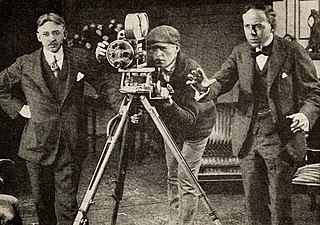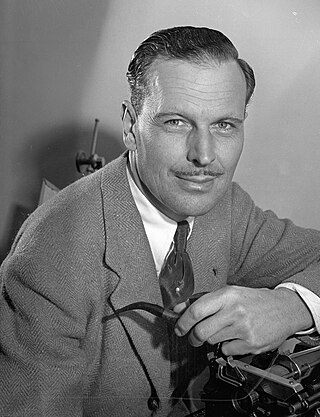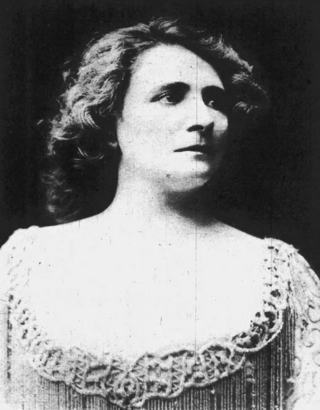
Joel Day was an American actor and artist who worked during the silent film era.

Joel Day was an American actor and artist who worked during the silent film era.
Joel Arthur Day was born on 16 March 1861 in Hillsboro, Montgomery, Illinois. [1] He grew up in Salina, Kansas. [2]
Day was married to Elizabeth Mets on 28 December 1892, in Somerville, Somerset County, New Jersey. [3] [4]
In 1900 Day was living in New Jersey and working as an artist. [5] In 1910 Day listed his occupation as a designer for a magazine in the 1910 US Census. [6] He also acted in stock theater, eventually moving into silent film, [7] and continued to paint between film contracts. [2]
Day died in California on 23 November 1923. [8]

Francis William Powell was a Canadian-born American stage and silent film actor, director, producer, and screenwriter who worked predominantly in the United States. He is also credited with "discovering" Theda Bara and casting her in a starring role in the 1915 release A Fool There Was. Her performance in that production, under Powell's direction, quickly earned Bara widespread fame as the film industry's most popular evil seductress or on-screen "vamp".

Bessie Barriscale was an American actress who gained fame on the stage and in silent films.

William Bertram was a Canadian-born actor, director, and producer of films in the United States, working predominantly during the silent era. He performed in 68 motion pictures between 1912 and 1931 and directed 64 films for various studios between 1915 and 1927. Bertram was also an accomplished singer in stage productions.
James Searle Dawley was an American film director, producer, screenwriter, stage actor, and playwright. Between 1907 and the mid-1920s, while working for Edison, Rex Motion Picture Company, Famous Players, Fox, and other studios, he directed more than 300 short films and 56 features, which include many of the early releases of stars such as Douglas Fairbanks, Mary Pickford, Pearl White, Marguerite Clark, Harold Lloyd, and John Barrymore. He also wrote scenarios for many of his productions, including one for his 1910 horror film Frankenstein, the earliest known screen adaptation of Mary Shelley's 1818 novel. While film direction and screenwriting comprised the bulk of Dawley's career, he also had earlier working experience in theater, performing on stage for more than a decade and managing every aspect of stagecraft. Dawley wrote at least 18 plays as well for repertory companies and for several Broadway productions.

Carmen Phillips was an American actress of the silent era. She appeared in more than 60 films between 1914 and 1926, frequently as a "vamp".

George Walter Terwilliger was an American film director, screenwriter, and journalist. He worked in both the silent and sound eras, directing at least 76 productions between 1912 and 1936. He also wrote scores of screenplays for films released between 1910 and 1939. In 1912 alone, he was contracted by Lubin film studio to write one story a week for the company.

Mary MacLaren was an American film actress in both the silent and sound eras. She was the younger sister of actresses Miriam and Katherine MacDonald and appeared in more than 170 films between 1916 and 1949.

Charles Giblyn was an American film director and actor of the silent era. He directed nearly 100 films between 1912 and 1927. He also appeared in 23 films between 1914 and 1934. He was one of the founders of the Motion Picture Directors Association.

Arthur Rolette Berthelet was an American actor, stage and film director, dialogue director, and scriptwriter. With regard to screen productions, he is best remembered for directing the 1916 crime drama Sherlock Holmes starring William Gillette, an actor who since 1899 had distinguished himself on the Broadway stage and at other prominent theatrical venues with his numerous, "definitive" portrayals of Sir Arthur Conan Doyle's great fictional detective. In 1918, Berthelet also directed the controversial author and feminist Mary MacLane in Men Who Have Made Love to Me, a production notable for being among the first cinematic dramas to break the "fourth wall" and among the earliest American film projects to bring together on screen a woman's work as a published author, "scenarist", actor, and narrator through the use of intertitles.

Harold Marvin Shaw was an American stage performer, film actor, screenwriter, and director during the silent era. A native of Tennessee, he worked in theatrical plays and vaudeville for 16 years before he began acting in motion pictures for Edison Studios in New York City in 1910 and then started regularly directing shorts there two years later. Shaw next served briefly as a director for Independent Moving Pictures (IMP) in New York before moving to England in May 1913 to be "chief producer" for the newly established London Film Company. During World War I, he relocated to South Africa, where in 1916 he directed the film De Voortrekkers in cooperation with African Film Productions, Limited. Shaw also established his own production company while in South Africa, completing there two more releases, The Rose of Rhodesia in 1918 and the comedy Thoroughbreds All in 1919. After directing films once again in England under contract with Stoll Pictures, he finally returned to the United States in 1922 and later directed several screen projects for Metro Pictures in California before his death in Los Angeles in 1926. During his 15-year film career, Shaw worked on more than 125 films either as a director, actor, or screenwriter.

Violet Heming was an English stage and screen actress. Her name sometimes appeared as Violet Hemming in newspapers.

Die Augen der Mumie Ma is a 1918 German silent horror film directed by Ernst Lubitsch. The film stars Pola Negri as Ma, Emil Jannings as Radu, and Harry Liedtke as Wendland. It was the first collaboration between Lubitsch and Negri, a pairing that would go on to make worldwide successes such as Carmen (1918), Madame DuBarry (1919), and Sumurun (1920).

The Mummy is a 1911 American short silent film produced by the Thanhouser Company. The film details the story of Jack Thornton, a businessman, who is in love with Professor Dix's daughter. Jack purchases a mummy and plans to win his respect as an Egyptologist, but the mummy is reanimated in Jack's room by a live electrical wire. The mummy takes immediate interest in Jack, but is rejected and mummifies him. Before Professor Dix can cut up the now-mummified Jack, she returns and saves him. Jack explains everything and the film concludes with Professor Dix marrying the mummy.

Alfred Emory Johnson was an American actor, director, producer, and writer. As a teenager, he started acting in silent films. Early in his career, Carl Laemmle chose Emory to become a Universal Studio leading man. He also became part of one of the early Hollywood celebrity marriages when he wed Ella Hall.

Marion Morgan was an American choreographer and motion picture screenwriter and the longtime romantic partner of motion picture director Dorothy Arzner. Arzner lived for the last 40 years of her life with Morgan.

Louella Maxam was an American actress who performed in over 50 silent films from 1913 until 1921. She was often cast in comedies and Westerns, most notably being identified in 1915 as a "leading lady" in a series of shorts starring Tom Mix, who during the silent and early sound eras was promoted as the "Cowboy King of Hollywood". Later, she was a female lead in other films for various studios, including several productions featuring another early cowboy star, Franklyn Farnum. Following her departure from acting, Maxam worked in county and municipal government in California, including service with the Burbank police department, where in 1943 she was hired as that city's first "police woman".
Stella Wynne Herron was an American writer and suffragist whose work appeared in a variety of magazines, including Collier's, Sunset, and Weird Tales. She is most known for her 1916 short story "Shoes", which pioneering film director Lois Weber adapted into a film of the same name. The film is now considered a feminist classic in early cinema history.
Nellie Anderson was an American stage and film actress who worked during the silent film era.
The Egyptian Mummy is a 1914 American silent short comedy film produced and directed by Lee Beggs. This one reel film was released by Vitagraph Studios on the 16th December 1914.

Florence Ashbrooke was an actress on the London and New York stages, and in silent films.